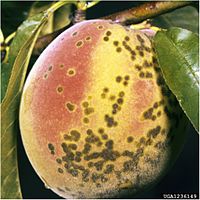
Photo from wikipedia
Apple scab, caused by Venturia inaequalis, can lead to large losses of marketable fruit if left uncontrolled. The disease appears in orchards during spring as lesions on leaves. These primary… Click to show full abstract
Apple scab, caused by Venturia inaequalis, can lead to large losses of marketable fruit if left uncontrolled. The disease appears in orchards during spring as lesions on leaves. These primary lesions are caused by spores released at bud burst from over-wintering sources; these spores can be sexually produced ascospores from the leaf litter or asexual conidia from mycelium in wood scab or within buds. We investigated the relative importance of conidia and ascospores as primary inoculum in an orchard in the United Kingdom. Potted trees not previously exposed to apple scab were placed next to (c. 1 m) orchard trees to trap air-dispersed ascospores. Number and position of scab lesions were assessed on shoots from both the potted trees (infection by airborne ascospores) and neighbouring orchard trees (infection by both ascospores and splash-dispersed conidia overwintered in buds). The distribution and population similarity of scab lesions were compared in the two tree types by molecular analysis and through modelling of scab incidence and count data. Molecular analysis was inconclusive. Statistical modelling of results suggested that conidia may have contributed approximately 20-50% of the total primary inoculum in this orchard: incidence was estimated to be reduced by 20% on potted trees, and lesion number by 50%. These results indicate that, although conidia are still a minority contributor to primary inoculum, their contribution in this orchard is sufficient to review current management. This might also be true of orchards with a similar climate.
Journal Title: Plant Pathology
Year Published: 2017
Link to full text (if available)
Share on Social Media: Sign Up to like & get
recommendations!